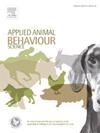Assessing the circadian rhythm of cats living in a group using accelerometers
IF 2.2
2区 农林科学
Q1 AGRICULTURE, DAIRY & ANIMAL SCIENCE
引用次数: 0
Abstract
Biological rhythms play a vital role in an organism’s survival, helping it align with environmental conditions like temperature, daylight, humidity, and available food. Research on the rhythmic behaviors of domestic cats remains sparse, and existing studies have produced varying results. This study aims to deepen our understanding of biological rhythms in domestic cats living in groups by using embedded accelerometers to track their activity patterns. Twelve cats from the AVA shelter in Cuy-Saint-Fiacre, France, wore collars with IMU sensors over a period of approximately three weeks, generating data that allowed us to quantify their activity patterns and explore their biological rhythms. Using this data, we calculated the cats' time budgets, categorizing behaviors into active and inactive states, and examined their day/night activity distribution as well as their hourly activity levels. Results showed that the cats were active 14.86 % of the day, on average, with higher activity levels during the day than at night. Moreover, a bimodal activity pattern with increased activity at the time of the caretaker's interventions at feeding time was found. These findings provide insights into the daily rhythms of domestic cats living in groups and highlight the influence of human interactions on their activity patterns.
求助全文
约1分钟内获得全文
求助全文
来源期刊

Applied Animal Behaviour Science
农林科学-行为科学
CiteScore
4.40
自引率
21.70%
发文量
191
审稿时长
18.1 weeks
期刊介绍:
This journal publishes relevant information on the behaviour of domesticated and utilized animals.
Topics covered include:
-Behaviour of farm, zoo and laboratory animals in relation to animal management and welfare
-Behaviour of companion animals in relation to behavioural problems, for example, in relation to the training of dogs for different purposes, in relation to behavioural problems
-Studies of the behaviour of wild animals when these studies are relevant from an applied perspective, for example in relation to wildlife management, pest management or nature conservation
-Methodological studies within relevant fields
The principal subjects are farm, companion and laboratory animals, including, of course, poultry. The journal also deals with the following animal subjects:
-Those involved in any farming system, e.g. deer, rabbits and fur-bearing animals
-Those in ANY form of confinement, e.g. zoos, safari parks and other forms of display
-Feral animals, and any animal species which impinge on farming operations, e.g. as causes of loss or damage
-Species used for hunting, recreation etc. may also be considered as acceptable subjects in some instances
-Laboratory animals, if the material relates to their behavioural requirements
 求助内容:
求助内容: 应助结果提醒方式:
应助结果提醒方式:


